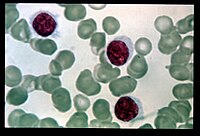
Photo from wikipedia
Hairy cell leukemia variant (HCLv) responds poorly to purine analog monotherapy. Rituximab concurrent with cladribine (CDAR) improves response rate, but long-term outcomes are unknown. We report final results of a… Click to show full abstract
Hairy cell leukemia variant (HCLv) responds poorly to purine analog monotherapy. Rituximab concurrent with cladribine (CDAR) improves response rate, but long-term outcomes are unknown. We report final results of a phase II study of CDAR for patients with HCLv. Twenty patients with 0-1 prior courses of cladribine and/or rituximab, including 8 previously untreated, received cladribine 0.15 mg/kg days 1-5 with 8 weekly rituximab doses 375 mg/m2. Patients received a 2nd rituximab course ≥6 months after cladribine, if/when minimal residual disease (MRD) was detected in blood. The complete remission (CR) rate from CDAR was 95%, 95% confidence interval (95%CI) 75-100%. Sixteen of 20 patients (80%, 95% CI: 56-94%) became MRD-negative by bone marrow at 6 months. The median duration of MRD-negative CR was 70.1 months and 7 of 16 are still MRD-negative up to 120 months. With median follow-up of 69.7 months, 11 patients received delayed rituximab and the 5-year progression-free survival (PFS) and overall survival (OS) were 63.3% and 73.9%, respectively. Five patients with TP53 mutations had shorter PFS (median: 36.4 months vs unreached, p=0.0024) and OS (median: 52.4 months vs unreached, p=0.032). MRD-negative CR at 6 months was significantly associated with longer PFS (unreached vs 17.4 months, p<0.0001) and OS (unreached vs 38.2 months, p<0.0001). Lack of MRD in blood at 6 months was also predictive of longer PFS and OS (p<0.0001). After progression following CDAR, median OS was 29.7 months. CDAR is effective in HCLv with better outcome in patients who achieved MRD-negative CR.
Journal Title: Blood advances
Year Published: 2021
Link to full text (if available)
Share on Social Media: Sign Up to like & get
recommendations!